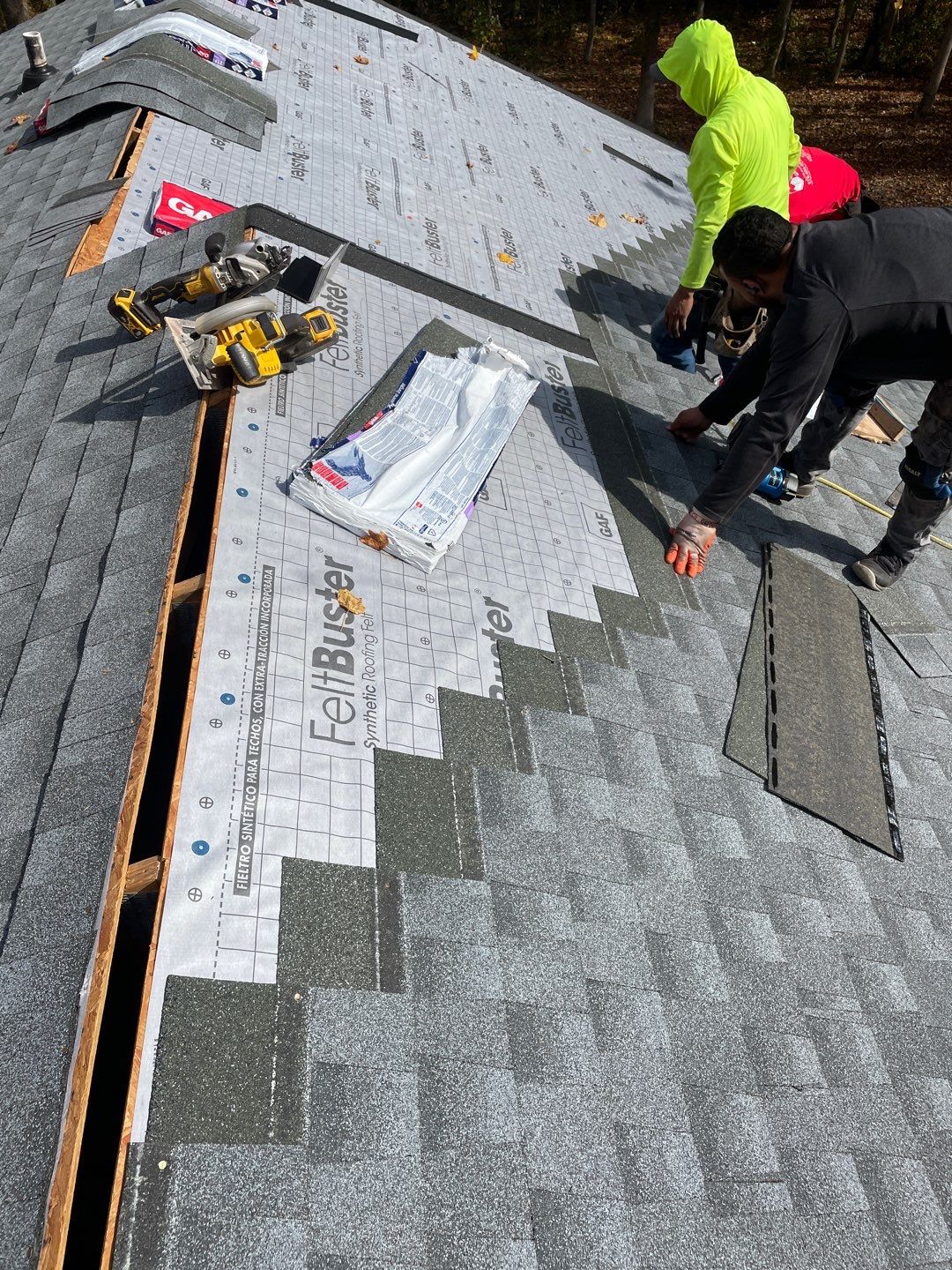Step-by-Step Overview to Locating the Right Roofing Companies in Gainesville
Step-by-Step Overview to Locating the Right Roofing Companies in Gainesville
Blog Article
Ideal Practices for Ensuring Appropriate Roof Covering Air Flow
Guaranteeing correct roofing air flow is important for the durability and effectiveness of a roof. A well balanced consumption and exhaust air vent ratio, commonly 1:300, plays a crucial function, with intake vents preferably positioned at the lower edge of the roof for amazing air entrance and exhaust vents at the optimal for cozy air exit. Normal evaluations to recognize clogs and maintain clear airflow are vital. Furthermore, keeping insulation away from vents is important to avoid airflow restriction. Understanding these fundamental components establishes the phase for more detailed understandings into setup and maintenance techniques that can considerably improve your roof's performance.
Understand Ventilation Essentials
Correctly recognizing air flow basics is essential for ensuring the durability and performance of roof. Effective air flow mitigates moisture buildup and temperature extremes in the attic, both of which can cause considerable architectural damage gradually. A well-ventilated roof aids in stopping common concerns such as mold development, timber rot, and ice dams, which can jeopardize the honesty of the roof covering materials and the underlying structures.
The main objective of ventilation is to help with the activity of air, enabling a constant exchange in between the outdoor and interior settings. This equilibrium is achieved via a mix of consumption and exhaust vents that interact to preserve ideal airflow. Consumption vents, usually located along the eaves or soffits, allow fresh air to enter the attic room, while exhaust vents, often positioned at or near the roofing system ridge, enable hot, damp air to leave.
Trick aspects affecting the efficiency of roofing system air flow consist of proper placement, ample sizing, and ensuring that both consumption and exhaust vents are unhampered. Normal assessment and maintenance are essential to determine prospective obstructions, damage, or ineffectiveness in the air flow system, therefore protecting the roofing's performance and durability.
Sorts Of Roofing Vents
Roof covering vents play an essential duty in maintaining efficient attic room ventilation and, by expansion, the overall health of the roofing system. Various kinds of roof covering vents are offered, each with one-of-a-kind advantages customized to details roof covering requirements. Ridge vents, for instance, are set up along the roofing system's peak, allowing warm, moist air to escape from the attic room. They provide continual ventilation and blend flawlessly with the roofline, making them both efficient and visually pleasing.

Soffit vents are mounted under the eaves and operate in tandem with roof covering vents to make sure a balanced intake and exhaust system. By enabling cooler air to enter from below, soffit vents assist in the expulsion of warm air with top vents. Gable vents, located on the outside wall surfaces of the attic room, offer another effective option, particularly in homes with saddleback roofs.
Assess Your Existing Ventilation

Following, think about the age and problem of your roof materials and air flow components. Older systems may not abide by present building regulations or might have degraded over time, lowering their effectiveness. Conduct an extensive evaluation to determine any kind of indicators of damage, such as rust, damage, or gaps that might compromise the system's performance.
Additionally, measure the attic room temperature and humidity degrees. High temperatures and moisture can show poor air flow - roofing companies in gainesville florida. Utilize a hygrometer and thermostat to acquire precise analyses, comparing them with outside problems. Consistent discrepancies suggest potential problems that require resolving.
Setup Best Practices
Efficient installation of roof ventilation systems is critical for making certain optimum performance and longevity. Correct installment begins with understanding the certain ventilation demands of the roof covering and the building it covers. This includes determining the right proportion of consumption to wear down vents, commonly adhering to the 1:300 policy, which stipulates one square foot of air flow for each 300 square feet of attic room flooring space.

Intake vents need to be set up at the roof's reduced side, commonly in the soffits, to allow amazing air to go into. Exhaust vents, on the various other hand, need to be mounted near or at the roof's top to assist in the leave of cozy, damp air.
Seal all air vent links carefully to stop air leakages and potential water seepage. Usage premium see here now materials and comply with producer guidelines to guarantee resilience and efficiency. In addition, integrating ridge vents with baffles can substantially boost air flow effectiveness by stopping wind-driven rainfall and snow from going into the attic.
Inevitably, exact installation of roof ventilation systems mitigates possible issues such as mold development, ice dams, and structural damages, ensuring the roof covering's stability and the building's general wellness.
Routine Upkeep Tips
Uniformity in maintenance methods is basic to making sure the long-lasting performance of roofing air flow systems. Routine examinations are essential, ideally executed biannually-- in the spring and fall. Throughout these assessments, ensure that vents are without debris, nests, and various other obstructions that can impede airflow. Look for any type of indications of moisture build-up or mold, as these can suggest improper ventilation or leakages (roofing companies in gainesville florida).
Cleaning the vents is another essential task. Utilize a soft brush or a vacuum cleaner to get rid of dirt and debris from consumption and exhaust vents. Be cautious not to damage the air vent displays or louvers during the procedure. Furthermore, inspect the attic space for any type of signs of water damage, which can jeopardize the stability of the roof system.
Correct insulation is equally crucial. Make certain that attic insulation does not block the vents, as this can badly limit airflow. Reposition or change it to preserve an effective obstacle. if any insulation has actually moved or resolved.
Finally, change any kind of damaged or missing elements promptly. Damaged vents, cracked tiles, or scrubby flashing can all contribute to poor air flow and should be resolved immediately. Regular maintenance makes sure that the roof air flow system works optimally, consequently extending the life-span of the roof itself.
Verdict
Ensuring correct roof ventilation is extremely important for maintaining the efficiency and durability of a roof system. Adherence to the 1:300 consumption and exhaust vent ratio, combined with the calculated placement of vents, is essential. Normal biannual inspections, particles cleaning, and ensuring insulation does not block airflow are critical techniques. Applying these finest techniques will promote a well-ventilated roof covering system, thereby mitigating potential problems associated with moisture accumulation and too much heat, inevitably prolonging the roof's life expectancy.
A balanced intake and exhaust air vent ratio, generally 1:300, plays a crucial role, with intake vents preferably put at the lower edge of the roof covering for amazing air access and exhaust vents at the height for warm air leave. Consumption vents, usually situated along the soffits or eaves, allow fresh air to get in the attic room area, while exhaust vents, frequently positioned at or near the roofing system ridge, make it possible for warm, damp air to leave.
Soffit vents are mounted under the eaves and work in tandem with roof vents to guarantee a balanced consumption and reference exhaust system. By enabling cooler air to enter from below, soffit vents promote the expulsion of warm air with top vents. Adherence to the 1:300 consumption and exhaust vent ratio, combined website here with the strategic positioning of vents, is necessary.
Report this page